American Regionalism and the Ashcan School were (pseudo-) movements in the first decades of the 20th century where (among other concerns) American painters tried to establish a territory against European predominance in modern art and tried to find their own voice and to develop their own style. However (as the term „regionalism“ indicates, and also due to the nationalism and conservatism of some of its proponents), they did, on the whole, not transgress and transcend the particular and the peculiar, the „local colour“ as Vincent would have said, into something more universal.
Edward Hopper, who originally was embedded in those traditions respectively who was confronted with them, he did. – The possibility of great art arises when someone embraces the local, the contigent, and penetrates it to such a degree as that he finds the universal and the eternal in it. The idiosyncratic is an emanation of the abstract, of totality, respectively is the modus in which the abstract, totality, seems to actualise itself, as a shade of God; at least that´s how great art presents it to us, the incompetent. In that fashion Hopper was not only a „painter of modern America“ but of universal truths.
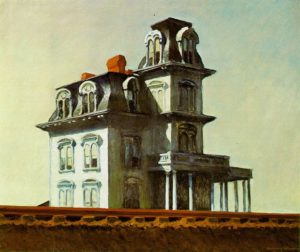 Art, painting in particular, is about the evocation of things (respectively their inner essence). In the paintings of Hopper what immediately seems to be evoked is the facade of objects; of unspectacular Houses by the Railroad, whose facades seem impenetrable; an unmysterious, unspectacular exterior as an inside-out of an interior supposedly of equal quality; if these houses in the middle of nowhere are inhabited at all. They´re presented as outposts of civilisation, maybe, as evidence that man has penetrated into nature by the means of culture, construction, technology, standardised mass production and taste, yet not into a nature that is presented to us as particularly violent, dangerous or overwhelming (i.e. with which man had to struggle which would involve drama), though also not actually as peaceful and tranquil. In Hopper´s paintings they´re presented as inexpressive objects in a vacuous nature. And that is where the actual artistic quality is rooted. It´s the inexpressiveness and the vacuousness which establishes a dialogue, telepathy, with the recipient. True art does not confront us with the meaning of something within a particular setting, but with meaning per se. It distills objects in a way that they become signifiers of meaning per se. And, as such, can circulate as a currency of meaning within all human context.
Art, painting in particular, is about the evocation of things (respectively their inner essence). In the paintings of Hopper what immediately seems to be evoked is the facade of objects; of unspectacular Houses by the Railroad, whose facades seem impenetrable; an unmysterious, unspectacular exterior as an inside-out of an interior supposedly of equal quality; if these houses in the middle of nowhere are inhabited at all. They´re presented as outposts of civilisation, maybe, as evidence that man has penetrated into nature by the means of culture, construction, technology, standardised mass production and taste, yet not into a nature that is presented to us as particularly violent, dangerous or overwhelming (i.e. with which man had to struggle which would involve drama), though also not actually as peaceful and tranquil. In Hopper´s paintings they´re presented as inexpressive objects in a vacuous nature. And that is where the actual artistic quality is rooted. It´s the inexpressiveness and the vacuousness which establishes a dialogue, telepathy, with the recipient. True art does not confront us with the meaning of something within a particular setting, but with meaning per se. It distills objects in a way that they become signifiers of meaning per se. And, as such, can circulate as a currency of meaning within all human context.
As Markus Gabriel notes, the meaning of art is that it confronts us with meaning per se. Art presents us objects of everyday life in a light in which they suddenly seem questionable, respectively in which their meaning isn´t entirely clear anymore. It displaces and disturbs objects in a way that both the objects as well as the entire world in which they are situated become both unfamiliar and hyper-familiar. Within such a loosening as well as definite identification of an object with itself, meaning itself, meaning per se, is revealed, as a both clear-cut and nebulous center which both can be located and always seems to be, evasively, on the move, which can definitely be looked right in the eye just to (make you) twinkle in the next moment, opening another perspective – in sum: a multitude of perspectives, a (pseudo-fractal) geometry of perspectives, etc. The greater the art, the higher and more comprehensive is the evocation of meaning.
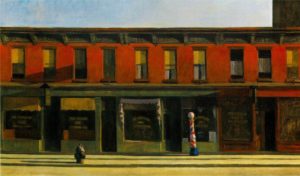 In their unspectacularity Hopper´s objects are highly charged with meaning and they are highly evocative. AAAAAAHH… what an evocation of facade! AAAAAAHH… what uneventfulness! AAAAAHH… what flatness! You have ambiguity in unambiguity; metaphysics in flatness; eventfulness in uneventfulness; familiarity in unfamiliarity; alienation in intimacy. A world, an object world (populated by subjects), which is so much identified with itself that it becomes truly meditative. It is not spectacular, but it is authentic. Hopper´s paintings bring out the element and cast light upon it. They function as a regognition of the single element, the uneventful, the imponderous. In great art you have a singling out of elements which then are charged with meaning. In great art the concretisation of the element at the same time means extraordinary abstraction of meaning from a regional context into the universal context.
In their unspectacularity Hopper´s objects are highly charged with meaning and they are highly evocative. AAAAAAHH… what an evocation of facade! AAAAAAHH… what uneventfulness! AAAAAHH… what flatness! You have ambiguity in unambiguity; metaphysics in flatness; eventfulness in uneventfulness; familiarity in unfamiliarity; alienation in intimacy. A world, an object world (populated by subjects), which is so much identified with itself that it becomes truly meditative. It is not spectacular, but it is authentic. Hopper´s paintings bring out the element and cast light upon it. They function as a regognition of the single element, the uneventful, the imponderous. In great art you have a singling out of elements which then are charged with meaning. In great art the concretisation of the element at the same time means extraordinary abstraction of meaning from a regional context into the universal context.
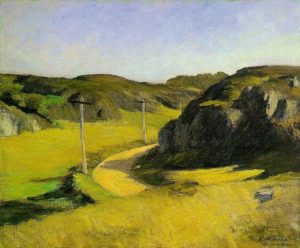 However it is not a world locked in itself, and although Hopper was somehow conservative he was not reactionary und staunchly unprogressive. It is not a small world, a petty world, a regionalist, xenophobic world that is presented; you rather have the openness of the prairie and of the city – although you have, of course, an ambigous look upon openness as well. Hopper´s paintings usually are cut-outs and out-takes, although, in some way, they are not actually segments. The roads and railroads usually seem to come from nowhere in particular and seem to go to nowhere in particular (House by the Railroad (1925), Road and Houses, South Truro (1930-33), The Camel´s Hump (1931), New York, New Haven and Hartford (1931), etc.). In Solitude (1944) the destination is an uninviteful one. In Road in Maine (1934), however, you have a curved road, leading to somewhere you cannot look at (which I find therefore terribly interesting). In Gas (1940) you have a solitary gas station explicitely as an outpost of civilisation along a street which leads into a seemingly consuming wilderness – it can be noted that in those paintings Hopper presents seemingly frail human architecture which obviously is bound to eventually get digested by nature the same way he seems to present is as an upright, in a humble way even heroic human effort to create his own realm and shelter within nature – and it seems the conflict between meanings is resolved that both visions are true, in addition to that: that there both seems to be a communion between man and his artifacts and nature as well as that there is incommensurability between them. What he actually seems to present is the synthesis of a kind of (meditative) indifference between them and the possibility for both communion or incommensurability, depending on the subject and depending on circumstances. There is, at least, a juxtaposition between nature and culture as well as there is a sense for amalgamation of both realms. (And concerning Gas, it was the metaphysicist De Chirico who spoke of the suggestiveness of an obscure background the picture seems to get drained into.)
However it is not a world locked in itself, and although Hopper was somehow conservative he was not reactionary und staunchly unprogressive. It is not a small world, a petty world, a regionalist, xenophobic world that is presented; you rather have the openness of the prairie and of the city – although you have, of course, an ambigous look upon openness as well. Hopper´s paintings usually are cut-outs and out-takes, although, in some way, they are not actually segments. The roads and railroads usually seem to come from nowhere in particular and seem to go to nowhere in particular (House by the Railroad (1925), Road and Houses, South Truro (1930-33), The Camel´s Hump (1931), New York, New Haven and Hartford (1931), etc.). In Solitude (1944) the destination is an uninviteful one. In Road in Maine (1934), however, you have a curved road, leading to somewhere you cannot look at (which I find therefore terribly interesting). In Gas (1940) you have a solitary gas station explicitely as an outpost of civilisation along a street which leads into a seemingly consuming wilderness – it can be noted that in those paintings Hopper presents seemingly frail human architecture which obviously is bound to eventually get digested by nature the same way he seems to present is as an upright, in a humble way even heroic human effort to create his own realm and shelter within nature – and it seems the conflict between meanings is resolved that both visions are true, in addition to that: that there both seems to be a communion between man and his artifacts and nature as well as that there is incommensurability between them. What he actually seems to present is the synthesis of a kind of (meditative) indifference between them and the possibility for both communion or incommensurability, depending on the subject and depending on circumstances. There is, at least, a juxtaposition between nature and culture as well as there is a sense for amalgamation of both realms. (And concerning Gas, it was the metaphysicist De Chirico who spoke of the suggestiveness of an obscure background the picture seems to get drained into.)
 Such a kind of outtakes which – paradoxically – do not actually appear to be segments but expressions of a, probably obscure, continuum Hopper not only sets within geography and space but also within time. Hopper suggests that he is displaying moments in time both in animated scenery and in unanimated, uninhabited scenery (Five A.M. (1937), Seven A.M. (1948), Early Sunday Morning (1930), or in the Cape Cod series, although Hopper may admit that their primary purpose is the study of light at a specific daytime). In the animated scenes Hopper seems nothing to depict but a moment. He is, on the surface, not at all a narrator. Yet those moments seem to reveal the narration of a whole life, not only in the physical dimension but also in the metaphysical dimension. – It has been remarked that Hopper is a painter who captures lonelieness, melancholia and alienation – and indeed, one of his significant epiphanies he had as a young painter who has spent some time in Paris and became aware of the stark contrast between the French joie de vivre and the vibrating intensity of Paris and the compartmentalised, secluded social life which was standard in America. But what Hopper actually seems to reveal is not a culturally relative isolation and melancholia – it is the shallowness of the ordinary human experience, an uneventful narrative, a drama of mundane scenes.
Such a kind of outtakes which – paradoxically – do not actually appear to be segments but expressions of a, probably obscure, continuum Hopper not only sets within geography and space but also within time. Hopper suggests that he is displaying moments in time both in animated scenery and in unanimated, uninhabited scenery (Five A.M. (1937), Seven A.M. (1948), Early Sunday Morning (1930), or in the Cape Cod series, although Hopper may admit that their primary purpose is the study of light at a specific daytime). In the animated scenes Hopper seems nothing to depict but a moment. He is, on the surface, not at all a narrator. Yet those moments seem to reveal the narration of a whole life, not only in the physical dimension but also in the metaphysical dimension. – It has been remarked that Hopper is a painter who captures lonelieness, melancholia and alienation – and indeed, one of his significant epiphanies he had as a young painter who has spent some time in Paris and became aware of the stark contrast between the French joie de vivre and the vibrating intensity of Paris and the compartmentalised, secluded social life which was standard in America. But what Hopper actually seems to reveal is not a culturally relative isolation and melancholia – it is the shallowness of the ordinary human experience, an uneventful narrative, a drama of mundane scenes.
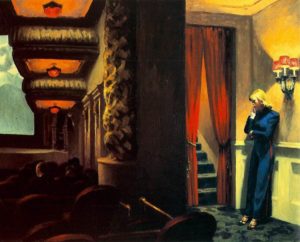 You are inclined to get to know what´s on those people´s minds or what they are looking at, reflecting upon. What are those women in Eleven A.M. (1926), Morning Sun (1952) or Room in Brooklyn (1932) gazing at as they look out of the window – or gazing into themselves as their view seems to be unfocused? What does the piece of paper the scene in Office at Night (1940) obviously is revolving around contain? What film are people watching in New York Movie (1939), with the exception of the female usher who seems to be mulling over her own thoughts (apparently it is a romantic, but trivial Hollywood movie)? What do those women read in their magazines in Hotel Lobby (1943) or Compartment C, Car 293 (1938)? Apparently there is no actual secret, and those people are but an reflection of their unspectacular circumstances, a mirror image – „emptiness reflected in emptiness“ (as one scholar, Wieland Schmied, puts it). More generally, in Hopper´s paintings – from his perspective of the „silent witness“ – you get a seemingly painfully precise and voyeuristic view on the most intimate realm of people – but what is revealed is that there actually seems to be nothing in particular, no secret, or what you would like to expect.
You are inclined to get to know what´s on those people´s minds or what they are looking at, reflecting upon. What are those women in Eleven A.M. (1926), Morning Sun (1952) or Room in Brooklyn (1932) gazing at as they look out of the window – or gazing into themselves as their view seems to be unfocused? What does the piece of paper the scene in Office at Night (1940) obviously is revolving around contain? What film are people watching in New York Movie (1939), with the exception of the female usher who seems to be mulling over her own thoughts (apparently it is a romantic, but trivial Hollywood movie)? What do those women read in their magazines in Hotel Lobby (1943) or Compartment C, Car 293 (1938)? Apparently there is no actual secret, and those people are but an reflection of their unspectacular circumstances, a mirror image – „emptiness reflected in emptiness“ (as one scholar, Wieland Schmied, puts it). More generally, in Hopper´s paintings – from his perspective of the „silent witness“ – you get a seemingly painfully precise and voyeuristic view on the most intimate realm of people – but what is revealed is that there actually seems to be nothing in particular, no secret, or what you would like to expect.
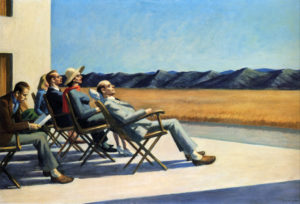 Likewise Hopper often depicts people who are on the move, who are waiting in a hotel lobby, riding a train, who are on vacation or who are in a transitory situation: in a restaurant, in a cafeteria, etc. The possibility of connection between strangers might arise, for instance in Sunlight at a Cafeteria (1958) or in People in the Sun (1960) but it is indicated they will not unfold. A scenario of a permanent transition which is a mirror image of a permanent stasis (in a more general sense, Hopper depicts moments that on the one hand are opened up into the unconcrete, the unspecific, the potential, the durable, the continuum; on the other hand they are frozen and static). Like everything in Hopper´s paintings the mimics and gestures of people are reduced but on the other hand more clear-cut and precise, evoking the essence and the core of the object/subject portrayed, yet again diffuse and ambiguous. Hopper´s people apparently do not display joy, it may be indicated that they express melancholy and inner tension but also that is resolved in some kind of quiet desperation, then some kind of stoicism, finally into a facade which does not actually reveal nor hide a lot – that´s the physiognomy of Hopper´s personage. Kind of unsettled are also the women/girls who look up at the sun or into a greater outside world (Summertime (1943), High Noon (1949) or Second Story Sunlight (1960)) where possibilities of another life seem to be indicated – though as a potential that is not likely to become actualised. (The light, in general, remains external in Hopper´s world. It is not a world of light but a rather dismal world where a cold light from above simply lays bare existential shortcomings, be it of the object world or of the subject world. Only the artist, the metaphysicist is light itself: As Hopper´s wife, Jo, surmised, the lighthouses Hopper often depicts in his paintings may be an alter ego; when asked about one of his last paintings, Sun in an Empty Room (1963), should express, Hopper at least replied: „Myself“.)
Likewise Hopper often depicts people who are on the move, who are waiting in a hotel lobby, riding a train, who are on vacation or who are in a transitory situation: in a restaurant, in a cafeteria, etc. The possibility of connection between strangers might arise, for instance in Sunlight at a Cafeteria (1958) or in People in the Sun (1960) but it is indicated they will not unfold. A scenario of a permanent transition which is a mirror image of a permanent stasis (in a more general sense, Hopper depicts moments that on the one hand are opened up into the unconcrete, the unspecific, the potential, the durable, the continuum; on the other hand they are frozen and static). Like everything in Hopper´s paintings the mimics and gestures of people are reduced but on the other hand more clear-cut and precise, evoking the essence and the core of the object/subject portrayed, yet again diffuse and ambiguous. Hopper´s people apparently do not display joy, it may be indicated that they express melancholy and inner tension but also that is resolved in some kind of quiet desperation, then some kind of stoicism, finally into a facade which does not actually reveal nor hide a lot – that´s the physiognomy of Hopper´s personage. Kind of unsettled are also the women/girls who look up at the sun or into a greater outside world (Summertime (1943), High Noon (1949) or Second Story Sunlight (1960)) where possibilities of another life seem to be indicated – though as a potential that is not likely to become actualised. (The light, in general, remains external in Hopper´s world. It is not a world of light but a rather dismal world where a cold light from above simply lays bare existential shortcomings, be it of the object world or of the subject world. Only the artist, the metaphysicist is light itself: As Hopper´s wife, Jo, surmised, the lighthouses Hopper often depicts in his paintings may be an alter ego; when asked about one of his last paintings, Sun in an Empty Room (1963), should express, Hopper at least replied: „Myself“.)
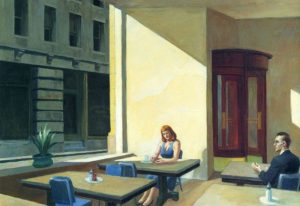 Hopper´s people are usually reduced to their social roles, or their genders, indicating they are, on the whole, identical with themselves, with not very much room for maneuvre. Children, who symbolise growth and potential, as well as innocence and complete absorption as well as realisation in themselves and in the moment they are situated, are absent. As Füssli/Fuseli remarks, children are lovely and charming to us because in their gestures the fullness and richness of the moment is revealed. In Hopper´s adults you seem to have the same thing – but it appears as a moment which is drained of its own substance, and of jouissance. And nevertheless: You never know what kind of drama may actually depicted and be the true substance of these mundane scenes. If the realities depicted in Hopper´s paintings do not strike you as truly meaningful to the spectator – respectively to the „silent witness“ – who knows what meaning and importance they carry for those who are situated in them? To reiterate: Great art establishes a constant dialogue with the spectator concerning what is the meaning the artwork carries, what does it try to tell, and it is, in those respects, always fluctuating. That is how those pieces of art are alive and are full of life. Yet another aspect of great art is that it immerses you. Not only intellectually or concerning pure curiosity, but also emotionally and ethically. You feel with those people and even with those unanimated scenes in Hopper´s paintings. They demand dignity and respect. They attract empathy. In the uneventfulness of the scenes a lot might go on. There´s a lot of potential, you see. In those moments, those segments, those outtakes you equally see the continuum. In those definite scenes you sense the possibility of openness. In those depictions of everyday lives, objects and people you have a singling out, an emphasis of the specific element, of the concrete, an appreciation for it. That makes the meditative, transcendent quality of Hopper´s paintings. That is how communion is established.
Hopper´s people are usually reduced to their social roles, or their genders, indicating they are, on the whole, identical with themselves, with not very much room for maneuvre. Children, who symbolise growth and potential, as well as innocence and complete absorption as well as realisation in themselves and in the moment they are situated, are absent. As Füssli/Fuseli remarks, children are lovely and charming to us because in their gestures the fullness and richness of the moment is revealed. In Hopper´s adults you seem to have the same thing – but it appears as a moment which is drained of its own substance, and of jouissance. And nevertheless: You never know what kind of drama may actually depicted and be the true substance of these mundane scenes. If the realities depicted in Hopper´s paintings do not strike you as truly meaningful to the spectator – respectively to the „silent witness“ – who knows what meaning and importance they carry for those who are situated in them? To reiterate: Great art establishes a constant dialogue with the spectator concerning what is the meaning the artwork carries, what does it try to tell, and it is, in those respects, always fluctuating. That is how those pieces of art are alive and are full of life. Yet another aspect of great art is that it immerses you. Not only intellectually or concerning pure curiosity, but also emotionally and ethically. You feel with those people and even with those unanimated scenes in Hopper´s paintings. They demand dignity and respect. They attract empathy. In the uneventfulness of the scenes a lot might go on. There´s a lot of potential, you see. In those moments, those segments, those outtakes you equally see the continuum. In those definite scenes you sense the possibility of openness. In those depictions of everyday lives, objects and people you have a singling out, an emphasis of the specific element, of the concrete, an appreciation for it. That makes the meditative, transcendent quality of Hopper´s paintings. That is how communion is established.
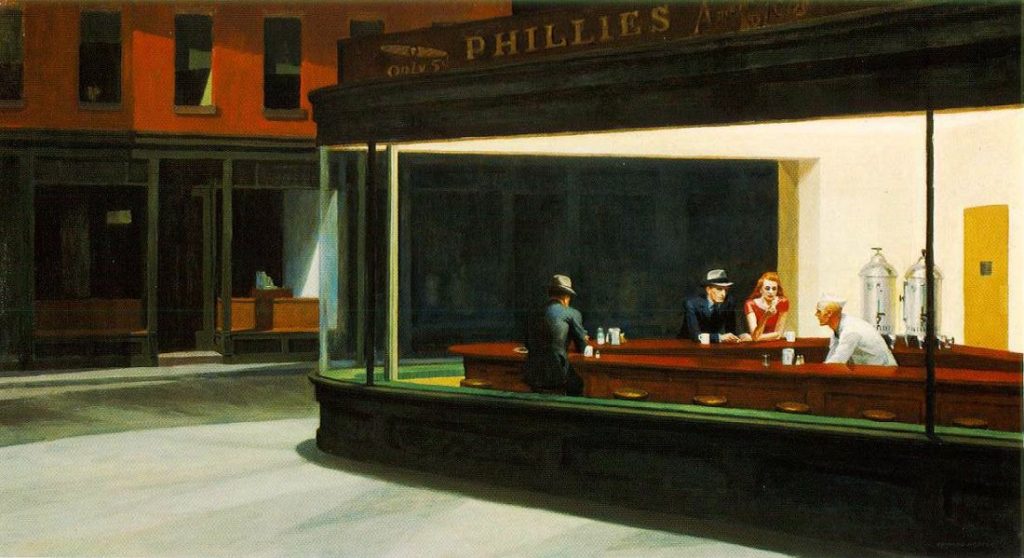 Hopper´s paintings are epiphanies of everyday life. While the Hyper-Genius presents a world that constantly explodes, into negatively curved space; while the Hyper-Genius constantly dislocates objects from their meanings and therefore opens room for maneuver, the Genius strictly identifies objects and meanings, to establish lucid clarity and (ambiguous) harmony. In doing so, he reveals the complexities and the ambiguities of the world as well. The gestures and the approaches differ, the significance is the same. In Hopper´s view upon the world there is only a narrow space between an entity and its possibilities. But there is vibration and fluorescence all alike. Luminosity. That is to say the artist casts light on the world and we see a lotta more. That will feel good.
Hopper´s paintings are epiphanies of everyday life. While the Hyper-Genius presents a world that constantly explodes, into negatively curved space; while the Hyper-Genius constantly dislocates objects from their meanings and therefore opens room for maneuver, the Genius strictly identifies objects and meanings, to establish lucid clarity and (ambiguous) harmony. In doing so, he reveals the complexities and the ambiguities of the world as well. The gestures and the approaches differ, the significance is the same. In Hopper´s view upon the world there is only a narrow space between an entity and its possibilities. But there is vibration and fluorescence all alike. Luminosity. That is to say the artist casts light on the world and we see a lotta more. That will feel good.
